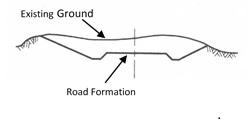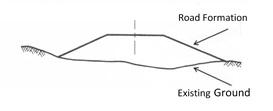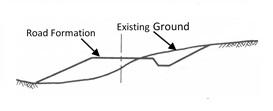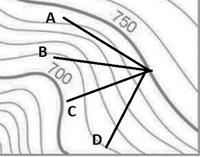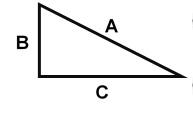Fundamentals Of Surveying: Test Your Knowledge Trivia Questions Quiz

Do you know the fundamentals of surveying? Do you think that you are so knowledgeable about surveying that you can pass the challenging quiz below on the basis of surveying? The best way to test your knowledge is to take the trivia questions. Do give it a try and get to see what facts you have forgotten already. All the best!
- 1.
Which of the following is a term used in linear surveying?
- A.
Traverse
- B.
Theodolite
- C.
Chainage
- D.
Total Station
Correct Answer
C. ChainageExplanation
Chainage is a term used in linear surveying to refer to the measurement of distances along a survey line. It is commonly used to mark specific points along a route or track, such as roads, railways, or pipelines. Chainage is typically measured using a chain or tape, and it helps in determining the exact location and distance between different points on a survey line.Rate this question:
-
- 2.
Which of the following is a term used in levelling surveying?
- A.
Staff
- B.
Traverse
- C.
Offset
- D.
Vertical angle
Correct Answer
A. StaffExplanation
The term "staff" is used in levelling surveying to refer to a long, slender, and graduated rod that is used to measure vertical distances or elevations. It is commonly used in conjunction with a levelling instrument to determine the difference in height between two points. The staff is typically marked with units of measurement, such as meters or feet, and is held vertically at the points being surveyed. By reading the graduations on the staff, the surveyor can determine the difference in elevation between the points.Rate this question:
-
- 3.
Which of the following is a term used in traverse surveying?
- A.
Staff
- B.
Ranging pole
- C.
Theodolite
- D.
Measuring tape
Correct Answer
C. TheodoliteExplanation
A theodolite is a term used in traverse surveying. It is a precision instrument that is used to measure angles in both the horizontal and vertical planes. It is commonly used in surveying to determine the direction and elevation of points on the earth's surface. The other options, such as staff, ranging pole, and measuring tape, are also used in surveying, but they are not specifically associated with traverse surveying.Rate this question:
-
- 4.
What is a global coordinate system?
- A.
UTM
- B.
ATM
- C.
BM
- D.
CP
Correct Answer
A. UTMExplanation
A global coordinate system, also known as UTM (Universal Transverse Mercator), is a geographic coordinate system that divides the Earth into 60 zones, each with a unique grid system. It is widely used for mapping and navigation purposes, allowing locations to be accurately represented using a combination of easting and northing coordinates. UTM provides a standardized way of referencing locations on a global scale, making it easier to communicate and share geographic data across different systems and applications.Rate this question:
-
- 5.
What is Mean Sea Level (MSL)?
- A.
Average point between high and low tide over time
- B.
Universal Traverse Mercator
- C.
Prime Meridian
- D.
Equator
Correct Answer
A. Average point between high and low tide over timeExplanation
Mean Sea Level (MSL) refers to the average point between high and low tide over a period of time. It is used as a reference point for measuring elevations and depths. MSL is important in various fields such as navigation, surveying, and coastal engineering as it provides a consistent baseline for these activities. By taking into account the fluctuations of tides, MSL helps to establish a standard reference for measuring and comparing sea levels at different locations.Rate this question:
-
- 6.
What is a Benchmark (BM)?
- A.
Back sight
- B.
A point of known E,N only
- C.
A point of known elevation
- D.
Inaccessible point
Correct Answer
C. A point of known elevationExplanation
A benchmark (BM) is a point of known elevation. It is a reference point used in surveying and construction to establish vertical measurements. By knowing the elevation of a benchmark, surveyors can accurately determine the elevation of other points in the area. This helps in ensuring that structures are built at the correct height and that accurate measurements are taken for various purposes.Rate this question:
-
- 7.
What is the height of collimation (HOC) for a Level?
- A.
Back sight
- B.
Height of the instrument after setting up
- C.
A point of known elevation
- D.
Reading on staff
Correct Answer
B. Height of the instrument after setting upExplanation
The height of collimation (HOC) for a Level refers to the height of the instrument after it has been set up. This is an important measurement in surveying as it allows for accurate leveling and the determination of elevations. By knowing the HOC, surveyors can calculate the difference in elevation between different points on the ground.Rate this question:
-
- 8.
What is the smallest gradations measurement on a staff in ordinary levelling?
- A.
1.0m
- B.
0.1m
- C.
0.01m
- D.
0.001m
Correct Answer
C. 0.01mExplanation
The smallest gradations measurement on a staff in ordinary leveling is 0.01m. This means that the staff can be measured in increments of 0.01 meters, allowing for more precise and accurate measurements in the leveling process.Rate this question:
-
- 9.
What is the first reading that you take after setting up the level?
- A.
FS
- B.
BS
- C.
BM
- D.
IS
Correct Answer
B. BSExplanation
After setting up the level, the first reading that is taken is the BS (Backsight) reading. The backsight reading is the measurement taken on a point of known elevation, typically a benchmark, to establish a reference point for the level. This reading helps in determining the height difference between the instrument and the benchmark, which is crucial for accurate leveling.Rate this question:
-
- 10.
Where is the best place to set up the level?
- A.
Far away from BS
- B.
Far away from FS
- C.
Where it can target most points if not all
- D.
Near operating heavy machinery
Correct Answer
C. Where it can target most points if not allExplanation
The best place to set up the level is where it can target most points if not all. This means that the level should be positioned in a location that allows it to accurately measure and assess the heights or slopes of multiple points on a surface. By doing so, the level can provide a comprehensive and reliable analysis of the terrain or structure being measured.Rate this question:
-
- 11.
What is the correct formula to calculate the reduced level (RL) of last point?
- A.
BS+FS
- B.
IS-FS
- C.
HOC-FS
- D.
HOC+FS
Correct Answer
C. HOC-FSExplanation
The correct formula to calculate the reduced level (RL) of the last point is HOC-FS. HOC stands for height of collimation, which is the height of the line of sight of the instrument. FS represents the foresight, which is the height of the staff at the last point. Subtracting the foresight from the height of collimation gives us the reduced level of the last point.Rate this question:
-
- 12.
What does a contour line represent?
- A.
A group of points with the same elevation
- B.
Horizontal distance between two points
- C.
The angle between two lines
- D.
Levelling grid
Correct Answer
A. A group of points with the same elevationExplanation
A contour line represents a group of points with the same elevation. Contour lines are used on topographic maps to show the shape and elevation of the land. Each contour line connects points of equal elevation, allowing us to visualize the changes in elevation across a specific area. By studying contour lines, we can determine the steepness of slopes, identify valleys and ridges, and understand the overall topography of a region.Rate this question:
-
- 13.
Which statement is correct for this road cross section?
- A.
Fill only section
- B.
Cut only section
- C.
Cut and fill section
- D.
The formation level is above NGL
Correct Answer
B. Cut only sectionExplanation
The correct answer is "Cut only section" because the road cross section shows a slope that has been excavated or cut into the existing ground. There is no indication of any filling or embankment in the section, suggesting that only cutting has been done to create the road. Additionally, the formation level being above NGL is not relevant to determining the correct answer.Rate this question:
-
- 14.
Which statement is correct for this road cross-section?
- A.
Fill only section
- B.
Cut only section
- C.
Cut and fill section
- D.
The formation level is below NGL
Correct Answer
A. Fill only sectionExplanation
The correct answer is "Fill only section" because the road cross-section is filled with material, indicating that the road is built on top of the existing ground level. There is no indication of any cuts or excavations in the cross-section. Additionally, the statement "the formation level is below NGL" is not applicable to this question and does not provide any relevant information about the road cross-section.Rate this question:
-
- 15.
Which statement is correct for this road cross-section?
- A.
Fill only section
- B.
Cut only section
- C.
Cut and fill section
- D.
Road does not have a ditch
Correct Answer
C. Cut and fill sectionExplanation
The correct answer is "Cut and fill section." This means that the road cross-section includes both areas where the earth has been cut away and areas where fill material has been added. This is a common technique used in road construction to create a level surface and accommodate changes in elevation. The presence of both cut and fill sections indicates that the road has been built to conform to the natural topography of the area.Rate this question:
-
- 16.
Which reading is the correct reading for the staff illustrated?
- A.
1.68m
- B.
15m
- C.
16m
- D.
1.58m
Correct Answer
D. 1.58mExplanation
The correct reading for the staff illustrated is 1.58m.Rate this question:
-
- 17.
Which reading is the correct reading for the staff illustrated?
- A.
1.50m
- B.
15m
- C.
16m
- D.
1.55m
Correct Answer
A. 1.50mExplanation
The correct reading for the staff illustrated is 1.50m.Rate this question:
-
- 18.
Which reading is the correct reading for the staff illustrated?
- A.
1.64m
- B.
15m
- C.
16m
- D.
1.54m
Correct Answer
A. 1.64mExplanation
The correct reading for the staff illustrated is 1.64m.Rate this question:
-
- 19.
Which line on this contour map has the steepest slope?
- A.
Line A
- B.
Line B
- C.
Line C
- D.
Line D
Correct Answer
C. Line C -
- 20.
You mark the survey stations using a:
- A.
Staff
- B.
Ranging Pole
- C.
Tripod
- D.
Level
Correct Answer
B. Ranging PoleExplanation
The correct answer is Ranging Pole. Survey stations are marked using a ranging pole, which is a long pole with graduations or markings on it. It is used to establish reference points or benchmarks for measuring distances and elevations during surveying activities. The ranging pole is typically placed at the survey station and serves as a visual reference for the surveyors to take measurements and record data accurately.Rate this question:
-
- 21.
You use what type of measurements along the survey line:
- A.
Strolling
- B.
Walking
- C.
Running
- D.
Trotting
Correct Answer
C. RunningExplanation
The correct answer is "Running" because it is the only measurement type mentioned that is related to speed and movement. Strolling, walking, and trotting are all slower and less intense than running, which suggests that running is the appropriate measurement type for the survey line.Rate this question:
-
- 22.
A perpendicular offset is at?
- A.
30 degrees
- B.
90 degrees
- C.
180 degrees
- D.
270 degree
Correct Answer
B. 90 degreesExplanation
A perpendicular offset is at 90 degrees because a perpendicular line intersects another line at a right angle. In other words, it forms a 90-degree angle with the line it is intersecting.Rate this question:
-
- 23.
Which of these surveying equipment can be used for linear surveys?
- A.
Staff
- B.
Theodolite
- C.
Measuring tape
- D.
Level
Correct Answer
C. Measuring tapeExplanation
A measuring tape can be used for linear surveys as it allows for accurate measurement of distances in a straight line. It is a flexible and portable tool that can be easily carried and used to measure both short and long distances. The staff, theodolite, and level are not specifically designed for linear surveys. The staff is used for measuring vertical distances, the theodolite is used for measuring angles and horizontal distances, and the level is used for determining the horizontal level of a surface. Therefore, the measuring tape is the most suitable equipment for linear surveys.Rate this question:
-
- 24.
Which of these surveying equipment can be used for linear surveys?
- A.
Staff
- B.
Theodolite
- C.
Measuring wheel
- D.
Level
Correct Answer
C. Measuring wheelExplanation
A measuring wheel can be used for linear surveys because it is designed to measure distances in a straight line. It typically has a wheel that rolls along the ground, and as it rolls, it counts the number of revolutions to calculate the distance traveled. This makes it an effective tool for measuring linear distances such as roads, paths, or fences. On the other hand, a staff is used for measuring vertical distances, a theodolite is used for measuring angles and horizontal distances, and a level is used for determining the horizontal plane.Rate this question:
-
- 25.
It is important to choose an appropriate paper size for drawing surveying maps. What size is A3 paper?
- A.
210mm*297mm
- B.
841mm*1189mm
- C.
594mm*841mm
- D.
297mm*420mm
Correct Answer
D. 297mm*420mmExplanation
A3 paper size is 297mm*420mm. This size is commonly used for drawing surveying maps as it provides enough space to accurately depict the details of the map while still being manageable and easy to handle. The dimensions of A3 paper make it a suitable choice for surveying maps as it allows for a good balance between detail and convenience.Rate this question:
-
- 26.
What does 1:100 drawing scale mean in surveying?
- A.
100cm measured will be represented by 1cm on drawing
- B.
100m measured will be represented by 1cm on drawing
- C.
100cm measured will be represented by 10cm on drawing
- D.
100cm measured will be represented by 1m on drawing
Correct Answer
A. 100cm measured will be represented by 1cm on drawingExplanation
A 1:100 drawing scale means that 100cm measured in real life will be represented by 1cm on the drawing. This scale is commonly used in surveying to accurately depict large areas or structures on a smaller drawing. By using this scale, surveyors can effectively communicate measurements and dimensions in a more manageable and understandable format.Rate this question:
-
- 27.
Which direction is bearing angle measured from?
- A.
North direction and anticlockwise
- B.
North direction and clockwise
- C.
West direction and anticlockwise
- D.
West direction and clockwise
Correct Answer
B. North direction and clockwiseExplanation
Bearing angle is measured from the North direction and clockwise. This means that when determining the bearing angle of a point or object, you start from the North direction and rotate in a clockwise direction to the desired point. This convention is commonly used in navigation and surveying to provide a consistent and standardized way of measuring angles.Rate this question:
-
- 28.
At which direction does a compass precisely point?
- A.
North Pole
- B.
Magnetic North
- C.
South Pole
- D.
True North
Correct Answer
B. Magnetic NorthExplanation
A compass precisely points towards Magnetic North. This is because the needle of a compass aligns itself with the Earth's magnetic field, which is generated by the movement of molten iron in the Earth's outer core. Magnetic North is not the same as True North, which is the direction towards the North Pole. The difference between Magnetic North and True North is known as magnetic declination and varies depending on the location on Earth. Therefore, in order to navigate accurately, it is important to account for this declination when using a compass.Rate this question:
-
- 29.
What function does a Theodolite serve?
- A.
Take horizontal angle reading HR
- B.
Take vertical angle reading VR
- C.
Helps with determining the angle entrapped between two lines.
- D.
All of the above
Correct Answer
D. All of the aboveExplanation
A theodolite serves multiple functions. It can take horizontal angle readings (HR), vertical angle readings (VR), and it helps with determining the angle entrapped between two lines. Therefore, the correct answer is "All of the above."Rate this question:
-
- 30.
What is the bearing angle for West direction?
- A.
90º
- B.
180º
- C.
270º
- D.
360º
Correct Answer
C. 270ºExplanation
The bearing angle for West direction is 270° because in a standard compass, North is at 0°, East is at 90°, South is at 180°, and West is at 270°.Rate this question:
-
- 31.
Which formula is Pythagoras formula for right angle triangles?
- A.
A2 = B2 + C2
- B.
A2 = B2 - C2
- C.
A2 = C2 - B2
- D.
A = B + C
Correct Answer
A. A2 = B2 + C2Explanation
The Pythagorean theorem states that in a right-angled triangle, the square of the length of the hypotenuse (the side opposite the right angle) is equal to the sum of the squares of the lengths of the other two sides. Therefore, the correct formula is A2 = B2 + C2, where A represents the length of the hypotenuse, and B and C represent the lengths of the other two sides.Rate this question:
-
- 32.
The sum of the angles on a 3-sided shape is:
- A.
90º
- B.
180º
- C.
270º
- D.
360º
Correct Answer
B. 180ºExplanation
A 3-sided shape is called a triangle. The sum of the angles in a triangle is always 180 degrees. This is a well-known mathematical property. Therefore, the correct answer is 180º.Rate this question:
-
- 33.
How can you distinguish between a Level and Theodolite?
- A.
By the levelling bubble
- B.
By the tripod
- C.
By instrument colour
- D.
Level’s scope does not tilt or rotate vertically.
Correct Answer
D. Level’s scope does not tilt or rotate vertically.Explanation
A level and a theodolite are both surveying instruments used for measuring angles and distances. However, one way to distinguish between them is by looking at the scope. A level's scope does not tilt or rotate vertically, while a theodolite's scope does have the ability to tilt and rotate vertically. Therefore, if the scope of the instrument is unable to tilt or rotate vertically, it can be identified as a level rather than a theodolite.Rate this question:
-
Quiz Review Timeline +
Our quizzes are rigorously reviewed, monitored and continuously updated by our expert board to maintain accuracy, relevance, and timeliness.
-
Current Version
-
Mar 22, 2023Quiz Edited by
ProProfs Editorial Team -
Apr 27, 2019Quiz Created by
Amro Hamada
- Accounting Quizzes
- Advertising Quizzes
- Agriculture Quizzes
- Automotive Quizzes
- Brand Quizzes
- Business Accounting Quizzes
- Business Analyst Quizzes
- Business Development Quizzes
- Business Environment Quizzes
- Business Etiquette Quizzes
- Business Finance Quizzes
- Business Math Quizzes
- Business Organization Quizzes
- Business Plan Quizzes
- Business Process Quizzes
- Business Study Quizzes
- Business Technology Quizzes
- CEO Quizzes
- Collaboration Quizzes
- Company Quizzes
- Construction Quizzes
- Consumer Quizzes
- CSR Quizzes
- Customer Quizzes
- Customer Service Quizzes
- Development Quizzes
- Ecommerce Quizzes
- Employment Quizzes
- Entrepreneurship Quizzes
- Finance Quizzes
- Hospitality Quizzes
- Human Resources Quizzes
- Industry Quizzes
- International Business Quizzes
- Introduction To Business Quizzes
- Investment Quizzes
- Logistics Quizzes
- Management Quizzes
- Manufacturing Quizzes
- Marketing Quizzes
- Material Quizzes
- Media Quizzes
- Office Quizzes
- Organization Quizzes
- Principles Of Business Quizzes
- Printing Quizzes
- Product Quizzes
- Publishing Quizzes
- Real Estate Quizzes
- Retail Quizzes
- Sales Quizzes
- SAP Business One Quizzes
- Small Business Quizzes
- Source Quizzes
- Supply Quizzes
- Telecommunication Quizzes
- Trade Quizzes
- Transportation Quizzes
- Warehouse Quizzes
- Welding Quizzes
 Back to top
Back to top



